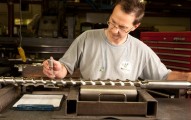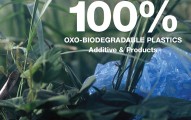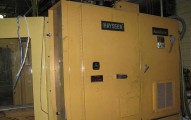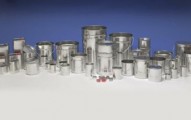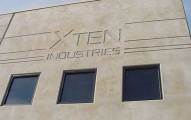Blue Shade of “Green” Sustainability
Initiatives on energy efficiency are harbinger to new sustainable technologies for injection moulding machine manufacturers. With VDMA having launched the Blue Competence in 2012 for sustainability in machinery, machine makers have taken up the initiative. But Angelica Buan also asks how relevant is it for Asia?
The United Nations Environment Program (UNEP) and the World Meteorological Organisation (WMO) have reported indications of ozone layer recovery, a successful outcome of the 1987 Montreal Protocol, which bans production and use of ozone-depleting substances. But the story does not end here, as experts say that while the ozone layer is being restored, the threat of climate changes still remains.
Consumption and production of energy, most of which comes from fossil fuels, contribute to climate change, according to the US Environment Protection Authority (EPA). Greenhouse gas emissions occur when energy is used inefficiently. Thus, industries are urged to mitigate climate change by following energy efficiency practices.
Europe’s new “green”
Worldwide, and especially in matured economies, industry regulations on environment preservations are being drawn up. Central Asia, US, and Europe are among the forerunners, with the World Bank (WB) allotting more than US$3 billion to Central Asia and Europe to support their respective energy efficiency projects. Taking this initiative, the European Commission (EC) is targeting a 20% cut in the region’s annual primary energy consumption by 2020.
Meanwhile, the UK-based European Bank for Reconstruction and Development (EBRD) launched the Sustainable Energy Initiative (SEI) in 2006 with “the aim of scaling up sustainable energy investments in the EU region, improving the business environment for sustainable investments, and removing key barriers to market development.”
Closer to the plastics and rubber sector, an industry focused initiative was espoused by the the German Engineering Federation (VDMA), which has brought forward the energy efficiency edge to its more than 3,000- member companies in the engineering industry.
Launched at the Fakuma show in 2012 by VDMA, it is known as the Blue Competence. It is the new “green” iconic colour associated with sustainability within the machinery equipment segment for plastics and rubber, according to Claudia Frey, Managing Director of VDMA.
Belgium-headquartered European Association of the Machine Tool Industries (CECIMO), which represents 15 national associations of machine tool builders, has also adopted the initiative for the machine tool sector.
“Efficiency means saving resources and hence costs. In Europe, the industry has almost doubled its production efficiency in the last 20 years. At the same time, the energy consumption of plastics machinery has fallen by 30%,” Frey said.
Energy efficiency label to come into force
The Blue Competence came about following the industry’s European umbrella organisation Euromap’s energy consumption guideline for machines, Euromap 60, which was issued in 2009, and was later revised and divided into two parts, 60.1 and 60.2, to reflect more consistent efficiency parameters.
“A study by Euromap concluded that further efficiency gains – in some cases as much as 50% – by 2020 are a realistic proposition,” said Frey.
She went on to say that the reduction of energy consumption can be achieved by replacing old machines, since most technologies are already available. However, companies are challenged by inconsistent information about energy consumption. “In many cases, apples and pears are compared. Therefore, Euromap has installed energy measurement standards, which bring about more transparency and competence to the issue.”
Frey said that Euromap will introduce energy labelling for plastics and rubber machinery by 1st October. Opting for this label is voluntary.
“The development of a common and neutral label will enable manufacturers to present the efficiency classes of their machines transparently. The detailed specification of the energy efficiency label is available as a free download for public information,” she added.
There are eight criteria for sustainability observed by participating VDMA members, based on the Blue Competence initiative.
“One of the criteria is to show that the firms in the capital goods industry use resources responsibly and have a substantial stake in giving us products with a viable future. The Blue Competence partner firms are able to illustrate this with many concrete examples,” said Frey.
A total of 400 firms have signed up for this initiative, 55 of which are members of the plastics and rubber machinery association (VDMA).
“That makes our industry a trailblazer among German plant and machinery manufacturers when it comes to environmental protection, conserving resources and managing efficiency,” she said.
Functional integration in injection moulding
One of the latest innovation buzzwords for injection moulding machines is functional integration, which basically combines varied materials with more advanced processes. Technology such as this enables the production of components and development of potential applications in a more sustainable way, since process steps are reduced and, hence, materials and energy used are also reduced.
However, functional integration, in order to be costeffective, has to satisfy process reliability, product quality, quantity of output, and time savings.
Munich-based machinery manufacturer KraussMaffei Group, responsible for the KraussMaffei and Netstal brands, is also amenable that sustainability (in the context of Blue Competence) is achieved through technologies that can conserve resources and allow for an efficient production.
One way of doing this is by multi-component technology, according to Dr Karlheinz Bourdon, Senior Vice-President Technologies, KraussMaffei Group. Nonetheless, he adds, producing parts from functionally integrated parts or processes may run up costs, unless, costs can be reduced.
Volker Aust, Head of Product Management at ultrasonic welding machine maker Herrmann Ultraschalltechnik also says that there has to be a point to functional integration. “If I integrate functions in an ultrasonic welding machine, I am accommodating a large number of processes in a very small space. The advantage for the customer is that a large number of processes can be performed by the same control system. The individual processes need not be high-tech.”
He also adds that functional integration is an incentive to acquire more skills so as to be able to trump the competition.
“It also increases the machine’s added value for customers and so they have all the more to gain. That too helps us to be competitive. As a machine maker, we keep on learning new things, mastering more interfaces, both mechanical and electrical. We are constantly optimising our products in a continuous improvement process (CIP),” Aust says.
Focus on energy efficiency
As with many German machine makers, machine maker Arburg appreciates functional integration as a sustainable process to produce new materials. The firm hosts annual Energy Efficiency awards event for customers who are able to follow the same commitment.
“In the recent years, Arburg has put tremendous effort in energy efficiency,” said David Chan, Managing Director, ASEAN region, during the recent Indoplas held in September in Jakarta, Indonesia.
According to Dr Thomas Walther, Manager of Applications Technology at Arburg, functional integration includes both enhanced component functionality and the interlinking and consolidation of process steps.
“In production efficiency, the aim is always high quality while keeping unit production costs to a minimum. High plant availability, high output and stable processes are also important factors in this context, since they ensure that resources such as energy or materials are not wasted.”
While he says that functional integration allows components to be made that would not otherwise exist, he adds that it is attractive for industries with series manufacturing.
Factoring in recycling
Meanwhile, Prof Georg Steinbichler, Head of Research and Development Technologies at Engel Austria, has a different take on sustainability and functional integration. He says that the industry has to consider recycling.
“Nowadays, a complex component or product is often made of a large number of different plastics, which makes them harder to recycle,” said Steinbichler, who is also Chairman of the Institute for Polymer Injection Moulding Technology and Process Automation at the Johannes Kepler University.
He suggests using single substances to facilitate recycling. “Where different materials are currently being used for different functions in a component, this could in future be, for example, an outer skin, a foam layer and a substrate of the same plastic. That would make recycling much easier. By combining several process technologies in one production plant, we can often also reduce the amount of raw material used,” he adds.
Is energy efficiency relevant to Asia?
When Claudia Frey of VDMA is asked how relevant the Blue Competence is in Asia, she replies, “The importance of energy savings due to costs but also with regard to irregular power supply within the Asian region (especially in countries like India) is tremendous. Improvements have to be fulfilled – partly driven by legislation. VDMA will address this issue specifically at the upcoming Chinaplas 2015 in Guangzhou next year. Alliance members of Blue Competence will showcase their latest achievements with regard to energy saving.”
While Walther of Arburg considers the level of automation greater in Europe and the US, in particular, he says the trend is clearly changing. “We are getting more enquiries for such automated systems from Asia because efficient production is growing in importance there too, and that means the cost of the machinery alone is no longer decisive.”
This is echoed by Bourdon of KraussMaffei. “We are seeing quite generally a trend towards ever more complex production cells. The level of automation is steadily increasing. In China, automation is already increasing today and it is only a question of time before highly complex automation is in demand there too.”
But the Chinese themselves are going all out to develop high-tech machinery, so will foreign manufacturers have any opportunities there at all in the future?
Steinbichler of Engel says that the Chinese who come to Austria from Engel’s factory in China, for example, are extremely well trained and highly motivated. “China also has a lot of university graduates with an outstanding level of education. If China makes full use of its young people’s potential, we will certainly feel the pinch. But I think it will be another ten years before that happens. We have advantages in process optimisation for example, in analytical and systematic problem solving. That is where we must focus and get even better ourselves. We must keep a step ahead.”
Bourdon also adds that European suppliers understand customising far better.
“That is also one reason why a lot of Chinese customers like to buy European products. This special ability of tailoring products and processes precisely to customers’ requirements, and to do so efficiently and cost-effectively, is a characteristic of European suppliers that is not found in China.”
Bourdon says that that is one of the reasons why European machinery makers are well positioned in some fields in China.
“We need to develop that. Then I am sure that we will be able to maintain our leading position,” he adds.


